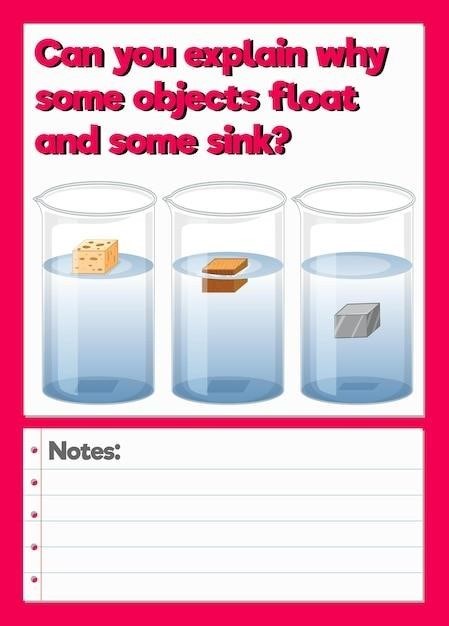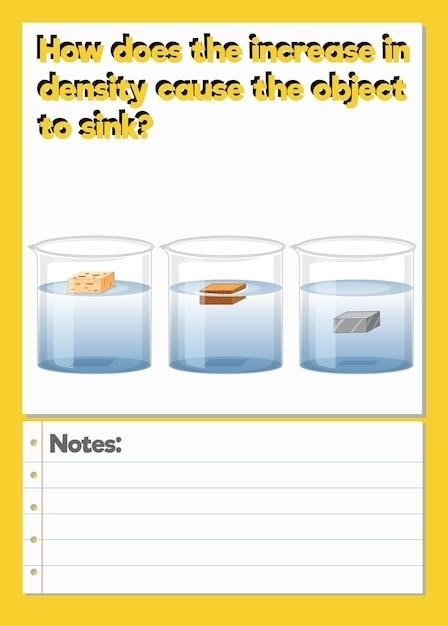Understanding Percentage Yield
Percentage yield quantifies the efficiency of a chemical reaction, comparing the actual yield to the theoretical maximum․
Theoretical yield is determined using stoichiometry, based on the balanced chemical equation and limiting reactant․
Actual yield is the experimentally measured amount of product obtained in a chemical reaction․
Percentage yield = (Actual yield / Theoretical yield) x 100%
Defining Percentage Yield
Percentage yield is a crucial concept in chemistry, representing the efficiency of a chemical reaction․ It’s defined as the ratio of the actual yield (the amount of product obtained experimentally) to the theoretical yield (the maximum amount of product that could be obtained based on stoichiometric calculations), expressed as a percentage․ A high percentage yield indicates a highly efficient reaction, while a low yield suggests losses due to various factors such as incomplete reactions, side reactions, or losses during product isolation․ Understanding percentage yield is essential for optimizing chemical processes and evaluating the success of experimental procedures․ Worksheets focused on percentage yield calculations provide practice problems with answers, allowing students to solidify their understanding of this important concept and its practical applications․ The calculation helps in determining the efficiency of a reaction and identifying areas for improvement․ These worksheets often incorporate diverse reaction types and scenarios to challenge students’ problem-solving skills․ Mastering percentage yield calculations is a fundamental skill for any aspiring chemist․
Calculating Theoretical Yield
Calculating theoretical yield is a cornerstone of stoichiometry, the area of chemistry dealing with quantitative relationships between reactants and products in chemical reactions․ To determine the theoretical yield, one must first have a balanced chemical equation representing the reaction․ This equation provides the molar ratios between reactants and products․ Next, identify the limiting reactant—the reactant that is completely consumed first, thus limiting the amount of product formed․ The moles of limiting reactant are then used, along with the molar ratio from the balanced equation, to calculate the moles of product that could be formed․ Finally, the moles of product are converted to grams using the molar mass of the product․ This final gram value represents the theoretical yield—the maximum amount of product that can be obtained if the reaction proceeds perfectly to completion, with no losses․ Percentage yield calculations heavily rely on accurately determining the theoretical yield, making this a vital step in chemical analysis and process optimization․ Practice worksheets often include examples to reinforce this process․
Calculating Actual Yield
Determining the actual yield involves experimental procedures and careful measurements․ Unlike the theoretical yield, which is a calculated value based on ideal conditions, the actual yield reflects the reality of a chemical reaction․ It represents the amount of product actually obtained after conducting the experiment․ This value is always less than or equal to the theoretical yield․ Several factors contribute to this discrepancy․ Incomplete reactions, side reactions forming unwanted byproducts, and losses during purification all reduce the actual yield․ To obtain the actual yield, the product must be isolated and purified․ This often involves techniques like filtration, distillation, or recrystallization․ The purified product is then weighed to determine its mass, which is subsequently converted to moles if needed for percentage yield calculations․ Accurate measurement is critical in determining the actual yield, as any error in weighing or measurement will directly impact the final calculation of the percentage yield․ Practice worksheets often emphasize the importance of accurate measurement techniques․
The Percentage Yield Formula
The percentage yield formula provides a straightforward method to assess the efficiency of a chemical reaction․ It’s a simple yet powerful tool for comparing the actual outcome of an experiment against the theoretically predicted outcome․ The formula itself is elegantly concise⁚ Percentage Yield = (Actual Yield / Theoretical Yield) x 100%․ The actual yield, representing the experimentally obtained amount of product, is divided by the theoretical yield, calculated stoichiometrically based on the limiting reactant․ This ratio is then multiplied by 100% to express the result as a percentage․ A percentage yield of 100% signifies perfect efficiency, meaning all reactants were converted to the desired product․ However, in practice, achieving a 100% yield is rare due to various factors including incomplete reactions, side reactions, and losses during product isolation and purification․ Percentage yield calculations are fundamental to evaluating the success of chemical synthesis and are frequently featured in chemistry worksheets and assessments, allowing students to practice using the formula and interpret its results within the context of real-world chemical processes․

Practical Application of Percentage Yield
Worksheets offer valuable practice in calculating percentage yield, applying the formula to diverse chemical reactions and scenarios presented with varying levels of complexity, enhancing understanding of theoretical and actual yields․
Example Problems⁚ Percentage Yield Calculations
Percentage yield worksheets often include example problems demonstrating the application of the formula․ These problems typically present a balanced chemical equation, along with the actual yield of the product․ Students are tasked with calculating the theoretical yield based on stoichiometry, often requiring them to identify the limiting reactant if more than one reactant is involved․ Once the theoretical yield is determined, students can then apply the percentage yield formula⁚ (Actual yield / Theoretical yield) x 100%․ The problems vary in complexity, ranging from straightforward calculations involving single-step reactions to more challenging scenarios with multi-step reactions or involving limiting reactants․ Detailed step-by-step solutions are usually provided in the answer key to guide students through the process and illustrate the correct methodology․ These examples help solidify understanding and build confidence in tackling more complex percentage yield problems independently․ The diverse range of problems ensures a comprehensive grasp of the concept and its application across various chemical contexts․ Careful analysis of these solved examples clarifies any ambiguities and reinforces the crucial relationship between stoichiometry, actual yield, and the overall percentage yield calculation․
Example Problems⁚ Limiting Reagents and Percentage Yield
Many percentage yield worksheets incorporate problems involving limiting reagents to challenge students’ understanding of stoichiometry and its impact on yield․ These problems present reactions with two or more reactants, requiring students to first identify the limiting reagent—the reactant that is completely consumed first, thus determining the maximum amount of product that can be formed․ The theoretical yield is calculated based solely on the amount of the limiting reagent․ Once the limiting reagent is identified and the theoretical yield is calculated, students proceed to determine the percentage yield using the standard formula⁚ (Actual yield / Theoretical yield) x 100%․ These problems emphasize the importance of determining the limiting reactant before calculating the theoretical yield, as using the amount of an excess reactant will lead to an inaccurate and inflated theoretical yield, resulting in an incorrect percentage yield․ Example problems often involve a step-by-step approach, guiding students through the process of identifying the limiting reagent, calculating the theoretical yield based on the limiting reactant, and finally determining the percentage yield․ This approach reinforces the connection between stoichiometry, limiting reagents, and the accurate calculation of percentage yield․
Advanced Problems⁚ Multi-Step Reactions and Percentage Yield
Advanced percentage yield problems often involve multi-step reactions, significantly increasing complexity․ These reactions consist of several sequential steps, each with its own theoretical and actual yields․ Calculating the overall percentage yield for a multi-step synthesis requires careful consideration of each individual step․ The actual yield of one step becomes the theoretical yield for the subsequent step, creating a cascade effect where errors or inefficiencies in earlier steps propagate through the entire process․ Students must calculate the theoretical yield for each step, considering limiting reagents at each stage, to determine the overall theoretical yield of the final product․ The actual yield of the final product is then used to calculate the overall percentage yield․ These problems are designed to assess a deeper understanding of stoichiometry, limiting reagents, and error propagation in chemical synthesis․ They challenge students to apply their knowledge comprehensively and systematically, demonstrating a mastery of chemical calculations and the practical implications of yields in complex reactions․ The inclusion of multi-step reactions in percentage yield worksheets prepares students for more realistic scenarios encountered in advanced chemistry․

Troubleshooting Low Percentage Yield
Low percentage yields in experiments necessitate identifying and rectifying errors․ Common causes include incomplete reactions, side reactions, and loss of product during purification․
Common Reasons for Low Percentage Yield
Several factors can contribute to a lower-than-expected percentage yield in chemical reactions․ Incomplete reactions, where the reactants don’t fully convert to products, are a frequent culprit․ This can stem from unfavorable reaction conditions like insufficient time, temperature, or catalyst concentration․ Side reactions, where unwanted products form alongside the desired one, also diminish the yield of the target compound․ These competing reactions may occur due to impurities in the reactants or inappropriate reaction conditions․ Furthermore, product loss during purification steps is a common issue․ Techniques like filtration, crystallization, or extraction aren’t perfect, leading to some product being lost in the process․ Experimental errors such as inaccurate measurements of reactants or incomplete transfer of materials can also significantly impact the actual yield and thus the percentage yield․ Finally, the reversibility of some reactions means that an equilibrium is reached, and not all reactants are converted into products․
Improving Percentage Yield in Experiments
Optimizing reaction conditions is crucial for maximizing percentage yield․ Ensuring the reaction proceeds to completion often involves adjusting factors like temperature, reaction time, and the concentrations of reactants․ Careful purification techniques minimize product loss during isolation and purification․ Techniques like recrystallization, distillation, or chromatography can enhance the purity and recovery of the desired product․ Using pure reactants is essential to prevent side reactions and improve the overall efficiency of the reaction․ Removing impurities before the reaction begins ensures that only the desired reaction pathway is followed․ Employing appropriate catalysts can significantly improve the reaction rate and drive the reaction towards completion, leading to higher yields․ Furthermore, meticulous experimental procedures, including accurate measurements and careful handling of materials, minimize errors and maximize product recovery․ Properly cleaning glassware and equipment is also vital to avoid contamination that might affect the reaction․
Resources for Further Learning
Numerous online resources and textbooks offer comprehensive guides and practice problems on percentage yield calculations․ Many websites provide downloadable worksheets with answers, facilitating self-study and skill development․ Consider exploring educational platforms and chemistry-focused websites for additional support․
Percentage Yield Worksheets with Answers (PDF)
The internet offers a plethora of percentage yield worksheets in PDF format, catering to various educational levels and learning styles․ These resources typically present a range of problems, from simple calculations involving direct application of the formula to more complex scenarios incorporating limiting reactants and multi-step reactions․ The inclusion of answers allows students to check their understanding and identify areas requiring further attention․ Many worksheets incorporate real-world examples, connecting theoretical concepts to practical applications in chemistry․ This hands-on approach enhances comprehension and encourages a deeper understanding of the underlying principles involved in determining percentage yield․ The availability of these resources ensures accessibility for students seeking additional practice beyond classroom instruction․ Whether preparing for exams or reinforcing concepts, these readily available PDFs provide invaluable support for mastering the concept of percentage yield in chemistry․